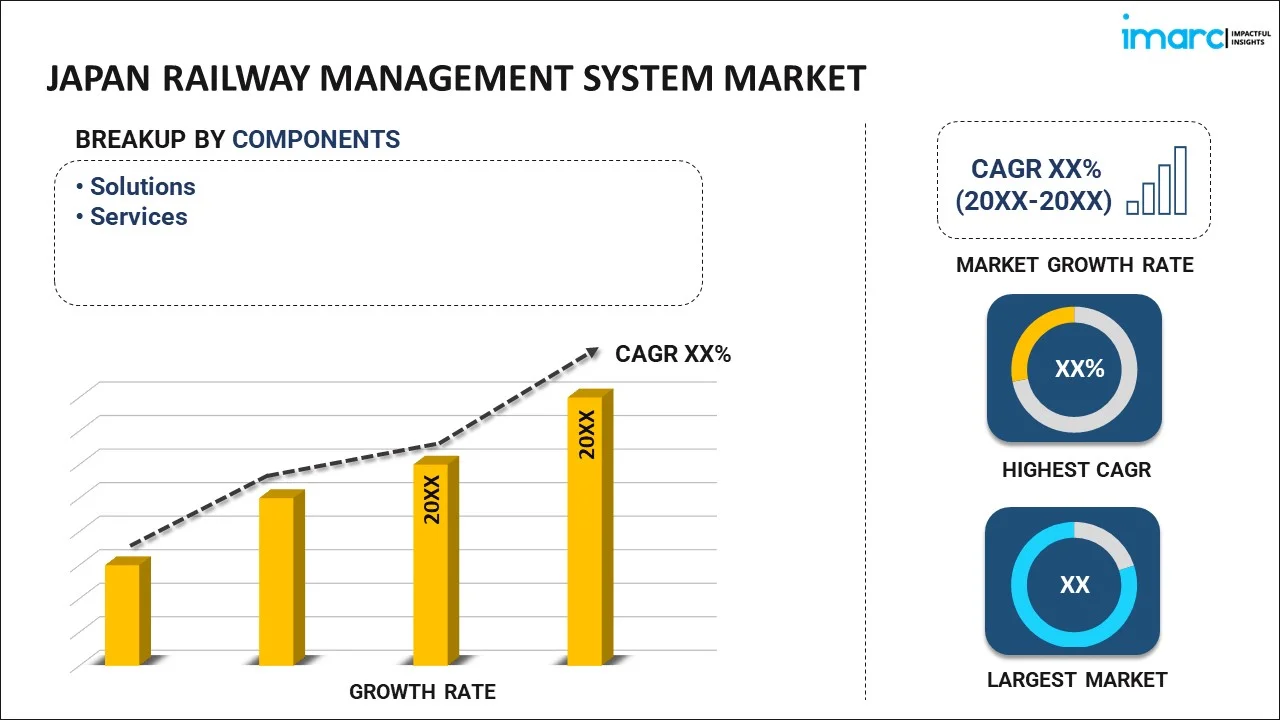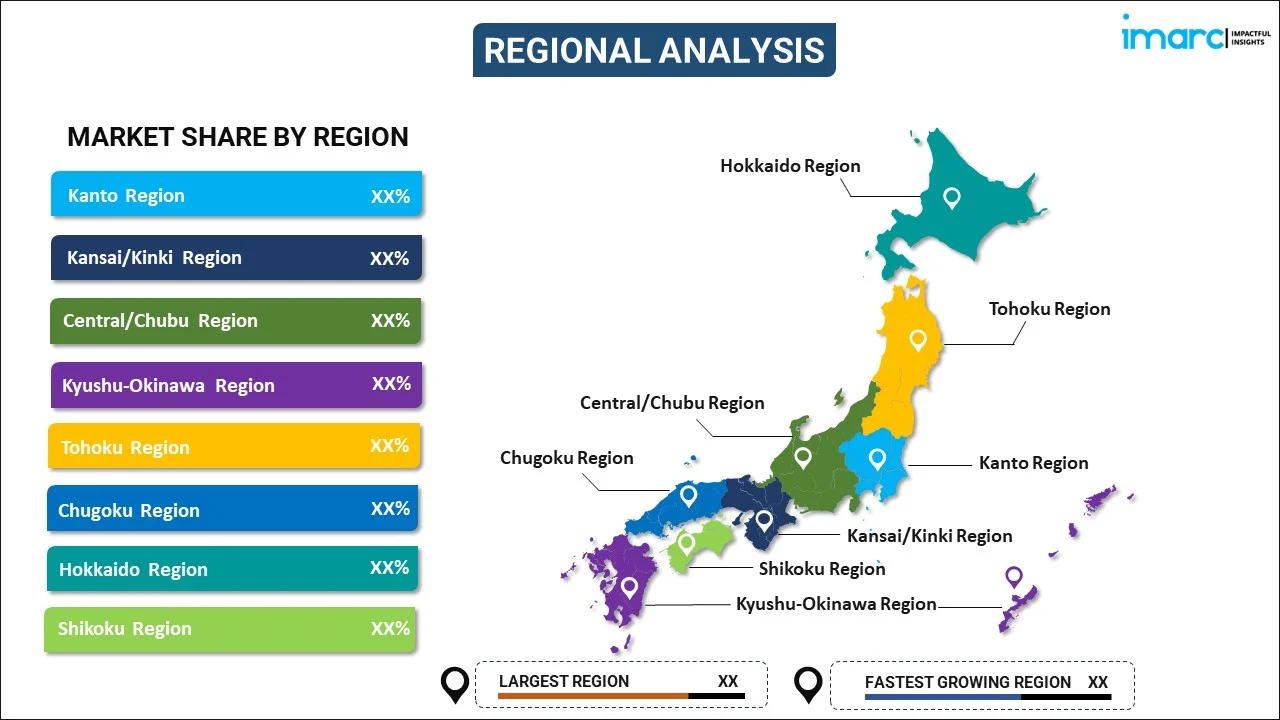
Japan Railway Management System Market Report by Component (Solutions, Services), Deployment Mode (On-premises, Cloud-based), Organization Size (Small and Medium-sized Enterprises, Large Enterprises), and Region 2025-2033
Market Overview:
Japan railway management system market size reached USD 3.7 Billion in 2024. Looking forward, IMARC Group expects the market to reach USD 9.0 Billion by 2033, exhibiting a growth rate (CAGR) of 10.5% during 2025-2033. The presence of a dense population, escalating focus on smart cities, Japan’s ongoing commitment to sustainability, recent advancements in artificial intelligence (AI) and machine learning (ML), and the rising tourism industry some of the key factors driving the market.
|
Report Attribute
|
Key Statistics
|
|---|---|
|
Base Year
|
2024 |
|
Forecast Years
|
2025-2033 |
|
Historical Years
|
2019-2024
|
| Market Size in 2024 | USD 3.7 Billion |
| Market Forecast in 2033 | USD 9.0 Billion |
| Market Growth Rate (2025-2033) | 10.5% |
Railway management systems refer to the suite of solutions and services used for managing and optimizing railway operations. They are available in various types, such as traffic management, asset management, control systems, and information systems. Railway management systems consist of components like sensors, software, services, and devices to facilitate communication and analytics. They offer numerous features, including real-time monitoring, data collection, scheduling, and asset optimization. Railway management systems find applications in train planning, routing, scheduling, tracking, maintenance, ticketing, and security. Additionally, they are used in passenger information systems, asset and workforce management, and emergency response services. Railway management systems aid in increasing operational efficiency, improving safety, reducing cost, and enhancing customer experience. In addition to this, they provide several advantages, such as real-time decision-making, scalability, data-driven insights, reduced carbon footprint, and interoperability between various systems.
Japan Railway Management System Market Trends:
The presence of a dense population, coupled with the increasing urbanization in Japan, which requires an efficient railway system, is propelling the market growth. Additionally, the escalating focus on smart cities, which involves integrating the Internet of Things (IoT) and big data into public transport, such as railways, is contributing to the market growth. Besides this, the government’s commitment to sustainability, prompting the development of eco-friendly and efficient rail systems, is catalyzing the market growth. Furthermore, recent advancements in artificial intelligence (AI) and machine learning (ML) that are enhancing predictive maintenance and safety measures are positively influencing the market growth. In addition, the rising tourism industry, necessitating a well-managed, efficient railway system, is driving the market growth. Apart from this, the growing need for real-time monitoring to ensure safety and schedule adherence, boosting the demand for advanced management systems, is supporting the market growth. Moreover, the increasing number of public-private partnerships, which is aiding rapid technology adoption, is further bolstering the market growth. Along with this, the implementation of favorable regulatory support in transportation infrastructure, creating a conducive environment for the market, is acting as another growth-inducing factor. In addition to this, the introduction of high-speed trains like the Shinkansen, which demand sophisticated management systems for seamless operation, is creating a positive outlook for the market growth. Furthermore, the rapid proliferation of mobile ticketing solutions is fueling the market growth. Besides, the widespread integration of renewable energy sources like solar power into railway operations is providing a boost to the market growth. Additionally, the escalating security concerns, necessitating advanced surveillance and monitoring systems, are accelerating the market growth.
Japan Railway Management System Market Segmentation:
IMARC Group provides an analysis of the key trends in each segment of the market, along with forecasts at the country level for 2025-2033. Our report has categorized the market based on component, deployment mode, and organization size.
Component Insights:

- Solutions
- Rail Asset Management System
- Rail Traffic Management System
- Rail Operation Management System
- Rail Control System
- Rail Maintenance Management System
- Passenger Information System
- Rail Security
- Services
- Training and Consulting
- System Integration and Deployment
- Support and Maintenance
- Managed Service
- Professional Service
The report has provided a detailed breakup and analysis of the market based on the component. This includes solutions (rail asset management system, rail traffic management system, rail operation management system, rail control system, rail maintenance management system, passenger information system, and rail security) and services (training and consulting, system integration and deployment, support and maintenance, managed service, and professional service).
Deployment Mode Insights:
- On-premises
- Cloud-based
A detailed breakup and analysis of the market based on the deployment mode have also been provided in the report. This includes on-premises and cloud-based.
Organization Size Insights:
- Small and Medium-sized Enterprises
- Large Enterprises
The report has provided a detailed breakup and analysis of the market based on the organization size. This includes small and medium-sized enterprises and large enterprises.
Regional Insights:

- Kanto Region
- Kansai/Kinki Region
- Central/ Chubu Region
- Kyushu-Okinawa Region
- Tohoku Region
- Chugoku Region
- Hokkaido Region
- Shikoku Region
The report has also provided a comprehensive analysis of all the major regional markets, which include Kanto Region, Kansai/Kinki Region, Central/ Chubu Region, Kyushu-Okinawa Region, Tohoku Region, Chugoku Region, Hokkaido Region, and Shikoku Region.
Competitive Landscape:
The market research report has also provided a comprehensive analysis of the competitive landscape. Competitive analysis such as market structure, key player positioning, top winning strategies, competitive dashboard, and company evaluation quadrant has been covered in the report. Also, detailed profiles of all major companies have been provided.
Japan Railway Management System Market Report Coverage:
| Report Features | Details |
|---|---|
| Base Year of the Analysis | 2024 |
| Historical Period | 2019-2024 |
| Forecast Period | 2025-2033 |
| Units | Billion USD |
| Scope of the Report | Exploration of Historical Trends and Market Outlook, Industry Catalysts and Challenges, Segment-Wise Historical and Future Market Assessment:
|
| Components Covered |
|
| Deployment Modes Covered | On-premises, Cloud-based |
| Organization Sizes Covered | Small and Medium-sized Enterprises, Large Enterprises |
| Regions Covered | Kanto Region, Kansai/Kinki Region, Central/ Chubu Region, Kyushu-Okinawa Region, Tohoku Region, Chugoku Region, Hokkaido Region, Shikoku Region |
| Customization Scope | 10% Free Customization |
| Post-Sale Analyst Support | 10-12 Weeks |
| Delivery Format | PDF and Excel through Email (We can also provide the editable version of the report in PPT/Word format on special request) |
Key Questions Answered in This Report:
- How has the Japan railway management system market performed so far and how will it perform in the coming years?
- What has been the impact of COVID-19 on the Japan railway management system market?
- What is the breakup of the Japan railway management system market on the basis of component?
- What is the breakup of the Japan railway management system market on the basis of deployment mode?
- What is the breakup of the Japan railway management system market on the basis of organization size?
- What are the various stages in the value chain of the Japan railway management system market?
- What are the key driving factors and challenges in the Japan railway management system?
- What is the structure of the Japan railway management system market and who are the key players?
- What is the degree of competition in the Japan railway management system market?
Key Benefits for Stakeholders:
- IMARC’s industry report offers a comprehensive quantitative analysis of various market segments, historical and current market trends, market forecasts, and dynamics of the Japan railway management system market from 2019-2033.
- The research report provides the latest information on the market drivers, challenges, and opportunities in the Japan railway management system market.
- Porter's five forces analysis assist stakeholders in assessing the impact of new entrants, competitive rivalry, supplier power, buyer power, and the threat of substitution. It helps stakeholders to analyze the level of competition within the Japan railway management system industry and its attractiveness.
- Competitive landscape allows stakeholders to understand their competitive environment and provides an insight into the current positions of key players in the market.
Need more help?
- Speak to our experienced analysts for insights on the current market scenarios.
- Include additional segments and countries to customize the report as per your requirement.
- Gain an unparalleled competitive advantage in your domain by understanding how to utilize the report and positively impacting your operations and revenue.
- For further assistance, please connect with our analysts.

 Inquire Before Buying
Inquire Before Buying
 Speak to an Analyst
Speak to an Analyst
 Request Brochure
Request Brochure
 Request Customization
Request Customization



.webp)




.webp)












